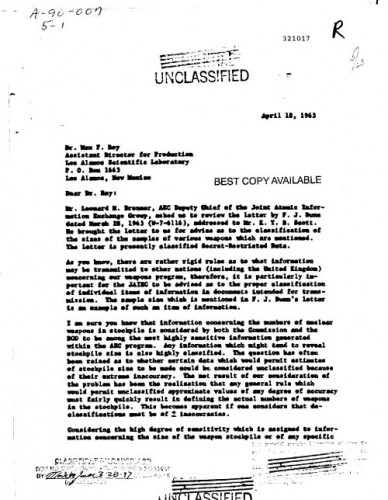Decades other than the 1940s and 1950s don’t get quite enough love on this blog, though they really ought to. Here’s a fun little document from 1963 in which the principle question under consideration is whether production information that would give deliberately inaccurate guesses about the size of the nuclear stockpile could be considered unclassified because of its misleading nature. 1
That is, the size of the stockpile was considered one of the great secrets of the Cold War. Because of this, production data that could be used to extrapolate the size of the stockpile was also considered a great secret. (If you knew how much U-235 was produced, and knew how much U-235 was used per weapon, then you could figure out the max stockpile size with just a little bit of arithmetic.)
But what if the production data gave you a totally wrong idea of what the stockpile size was? Was it then safe to release?
The director of AEC classification, Charles L. Marshall, said no. Inaccuracy did not make something unclassified:
I am sure you know that information concerning the numbers of nuclear weapons in stockpile is considered by both the Commission and the DOD to be among the most highly sensitive information generated within the AEC program. Any information which might tend to reveal stockpile size is also highly classified. The question has often been raised as to whether certain data which would permit estimates of stockpile size to be made could be considered unclassified because of their extreme inaccuracy. The net result of our consideration of the problem has been the realization that any general rule which would permit unclassified approximate values of any degree of accuracy must fairly quickly result in defining the actual numbers of weapons in the stockpile. This becomes apparent if one considers that declassification must be of (plus/minus) inaccuracies.
As Marshall reasoned, any such data would “bracket with impunity accurate values for the size of the stockpile,” and so “even highly inaccurate estimates of the size of the stockpile” had to be avoided. These rules could be changed, Marshall explained, but only if the Department of Defense was willing to concur in the changes.
I like the document both for its “rabbit hole” logic — once you start down the road of “this information is secret,” it quickly spreads so that all sorts of ostensibly only-somewhat-related information is also secret — and for its odd context. The question isn’t being asked because someone wants to make a public statement, but rather because they want to share information with the United Kingdom, a US ally. But as Marshall points out, rules are rules…
- Source: Charles L. Marshall to Max F. Roy (18 April 1963), copy in the Nuclear Testing Archive, Las Vegas, NV, document #NV0321017.[↩]


